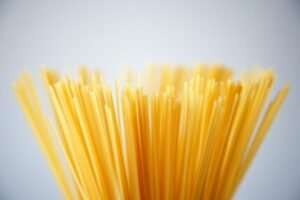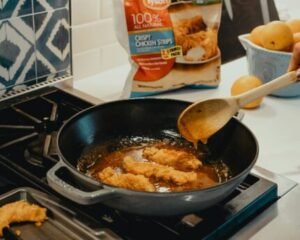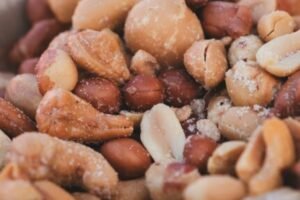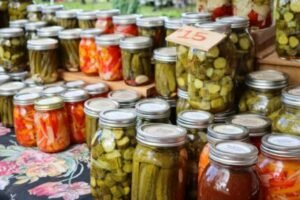Medically reviewed by Dr. Ramesh Gaddam, M.D. — Written by Sumalatha, D.N.H.E
Foods to Avoid with Glipizide
Here are the foods to avoid with Glipizide for effective controlling of blood sugar levels.
1. High-Sugar Foods
Consuming high-sugar foods can cause rapid spikes in blood sugar levels. When you eat sugary foods, your body quickly absorbs the sugar into your bloodstream. This leads to a rise in blood glucose, which can be challenging to manage, especially when taking Glipizide.
Consistently high blood sugar levels can interfere with how well the medication works and make it harder to control your diabetes.
Examples
- Candy: Includes sweets like chocolate bars and hard candies.
- Sugary Drinks: Such as soda, energy drinks, and sweetened iced tea.
- Pastries: Includes items like donuts, muffins, and cakes.
Tips for Alternatives
- Choose Fresh Fruit: Opt for fruits like apples, berries, and oranges, which provide natural sweetness and fiber.
- Select Unsweetened Beverages: Drink water, herbal teas, or sparkling water with a splash of lemon instead of sugary drinks.
- Go for Whole-Grain Snacks: Try whole-grain crackers or a handful of nuts for a satisfying, lower-sugar snack option.
2. Refined Carbohydrates
Refined carbohydrates can cause rapid increases in blood sugar. These foods are quickly broken down into sugar in your body, leading to spikes in glucose levels.
For people taking Glipizide, managing blood sugar is crucial, and refined carbs can make this more challenging.
They often lack fiber, which helps regulate blood sugar, making it harder to control diabetes effectively.
Examples
- White Bread, Pasta, Rice: Commonly processed and high in simple sugars.
- Pastries, Muffins, Bagels: Often made with refined flour and sugars.
- Crackers and Chips: Typically contain refined grains and added sugars.
Tips for Alternatives
- Opt for Whole Grains: Choose brown rice, whole-wheat bread, and whole-grain pasta.
- Choose Fiber-Rich Snacks: Try whole-grain crackers, popcorn, or raw vegetables.
- Experiment with Low-GI Foods: Look for foods that have a lower glycemic index, which help keep blood sugar stable.
3. Alcohol
Alcohol can impact how well Glipizide works and may lead to complications in blood sugar management.
Drinking alcohol can interfere with the medication’s effectiveness and may hide symptoms of low blood sugar, making it harder to detect and treat hypoglycemia.
Additionally, alcohol can increase the risk of hypoglycemia, especially if consumed on an empty stomach or in large amounts.
Impact
Tips for Safe Consumption
- Limit Alcohol Intake: Consume alcohol in moderation and with meals.
- Monitor Blood Sugar Levels: Check your blood sugar regularly, especially after drinking.
- Consult Your Doctor: Discuss alcohol use with your healthcare provider to understand safe limits.
4. Foods High in Saturated Fats
Saturated fats can negatively impact glucose metabolism and contribute to insulin resistance.
When consumed in excess, these fats may hinder the body’s ability to manage blood sugar effectively, making it harder to control diabetes while on Glipizide.
Examples
- Fried Foods: Such as French fries, fried chicken, and doughnuts.
- Fatty Cuts of Meat: Includes ribeye steak, pork belly, and bacon.
- Butter: Commonly used in cooking and baking.
Healthier Fat Choices
- Opt for Unsaturated Fats: Use olive oil, avocado, and nuts, which are better for heart health and blood sugar control.
- Choose Lean Proteins: Select skinless poultry, fish, and plant-based proteins to reduce saturated fat intake.
- Incorporate Omega-3s: Include fatty fish like salmon and flaxseeds, which have beneficial effects on overall health.
5. High-Sodium Foods
High sodium intake can elevate blood pressure and strain your heart, leading to potential cardiovascular issues.
For people with diabetes, managing blood pressure is crucial, as high sodium levels can complicate overall health and make blood sugar management more challenging.
Examples
- Processed Snacks: Includes items like chips, pretzels, and salted nuts.
- Canned Soups: Often high in sodium used for preservation and flavor.
- Fast Food: Includes burgers, fries, and pizza, which are typically high in sodium.
Low-Sodium Alternatives
- Fresh Fruits and Vegetables: Naturally low in sodium and high in essential nutrients.
- Home-Cooked Meals: Use herbs and spices for flavor instead of salt.
- Low-Sodium Products: Opt for low-sodium versions of soups, sauces, and snacks.
6. Grapefruit and Grapefruit Juice
Grapefruit and grapefruit juice can interact with Glipizide, potentially altering how the medication works.
Grapefruit contains compounds that affect the enzymes responsible for metabolizing certain drugs, including Glipizide.
This interaction can lead to higher levels of the medication in the blood, increasing the risk of side effects and impacting blood sugar control.
Potential Effects on Medication Efficacy
The interaction may reduce the effectiveness of Glipizide or increase the risk of adverse effects.
Consuming grapefruit or grapefruit juice can make it harder to maintain stable blood sugar levels, complicating diabetes management.
Alternative Fruit Options
- Apples: A great low-glycemic fruit that doesn’t interfere with medications.
- Berries: Such as strawberries, blueberries, and raspberries, which are high in fiber and antioxidants.
- Oranges: Provide vitamin C and are generally safe for those on Glipizide.
7. Foods with High Glycemic Index
Foods with a high glycemic index (GI) cause a rapid increase in blood sugar levels.
These foods are quickly broken down into glucose, leading to spikes in blood sugar. For those taking Glipizide, consuming high-GI foods can make it more challenging to manage diabetes effectively.
Examples
- White Potatoes: Known for causing quick spikes in blood sugar.
- Sugary Cereals: Often high in sugar and refined carbs, leading to rapid glucose increases.
Tips for Choosing Low-GI Foods
- Opt for Whole Grains: Choose whole-wheat bread, brown rice, and quinoa for a slower rise in blood sugar.
- Include Non-Starchy Vegetables: Add vegetables like spinach, broccoli, and peppers, which have a low GI.
- Select Fruits Wisely: Choose fruits like apples, pears, and berries, which have a lower glycemic index compared to tropical fruits.
8. Processed and Packaged Foods
Processed and packaged foods often contain additives and preservatives that can negatively affect blood sugar levels.
These ingredients may include hidden sugars and unhealthy fats that can lead to insulin resistance and disrupt blood sugar control.
Additionally, these foods tend to be low in essential nutrients and fiber, which are important for maintaining stable blood sugar levels.
Examples
- Packaged Meals: Often high in sodium, sugar, and unhealthy fats.
- Sugary Sauces: Includes items like barbecue sauce and ketchup, which may contain added sugars.
Fresh Food Options
- Fruits and Vegetables: Naturally nutrient-dense and low in added sugars and unhealthy fats.
- Lean Proteins: Such as fresh poultry, fish, and legumes, which are better for blood sugar management.
- Whole Grains: Include options like quinoa, brown rice, and oats for fiber and sustained energy.
2. Recommended Foods
Whole Grains
Whole grains like quinoa, brown rice, oats, and whole wheat bread and pasta are excellent choices for managing blood sugar.
They are rich in fiber and essential nutrients, which help regulate blood sugar levels and provide sustained energy.
Incorporating these grains into your diet can support better glucose control and overall health.
Fruits and Vegetables
Fruits and vegetables are essential for a balanced diet, particularly when focusing on low-glycemic options like berries, citrus fruits, and leafy greens.
These choices are high in fiber, vitamins, and minerals, which support stable blood sugar levels and overall health.
Including a variety of these nutrient-rich foods in your diet can help manage diabetes more effectively.
Lean Proteins
Lean proteins such as chicken, fish, tofu, and legumes are great additions to your diet.
They help maintain muscle mass and keep you feeling full for longer periods, which can aid in blood sugar management.
Including these proteins in your meals supports overall health and helps stabilize glucose levels.
Healthy Fats
Healthy fats, like those found in olive oil, avocado, and nuts, provide essential energy and help you feel full longer.
These fats support heart health and contribute to overall well-being. Including them in your diet can enhance blood sugar control and offer numerous health benefits.
Meal Planning Tips
To effectively manage your blood sugar while taking Glipizide, aim to eat regular, balanced meals that include a mix of proteins, healthy fats, and carbohydrates.
Practice portion control to manage carbohydrate intake and help stabilize blood sugar levels.
Space your meals evenly throughout the day to avoid large fluctuations in glucose levels. A
Additionally, staying well-hydrated by drinking plenty of water supports overall health and aids in glucose regulation.
Frequently Asked Questions (FAQs)
What Should You Avoid When Taking Glipizide?
When taking Glipizide, avoid high-sugar and refined carbohydrate foods, limit alcohol intake, and steer clear of grapefruit. These can interfere with the medication’s effectiveness and impact blood sugar control.
What Happens If You Take Glipizide After You Eat?
Taking Glipizide after a meal can still be effective, but it may not work as quickly to lower blood sugar. It’s generally recommended to take it before meals to optimize its effects.
Can I Take Glipizide at Night?
Glipizide is typically taken before meals, but if prescribed, it can be taken at night. Follow your healthcare provider’s instructions on the best time for your doses.
What Is the Most Common Side Effect of Glipizide?
The most common side effect of Glipizide is low blood sugar (hypoglycemia), which can cause symptoms like sweating, shaking, and dizziness.
What Organ Does Glipizide Affect?
Glipizide primarily affects the pancreas, stimulating it to release more insulin to help manage blood sugar levels.
How Can I Reduce the Side Effects of Glipizide?
To reduce side effects, monitor your blood sugar regularly, follow a balanced diet, take the medication as prescribed, and consult your healthcare provider for any adjustments.
When Should Glipizide Be Stopped?
Glipizide should be stopped if severe side effects occur or if blood sugar levels become difficult to control. Always consult your healthcare provider before making any changes to your medication regimen.
Why Is Glipizide a High-Risk Medication?
Glipizide is considered high-risk due to its potential to cause significant drops in blood sugar (hypoglycemia) and interactions with other medications.
Is Glipizide Safe for Heart?
Glipizide is generally safe for the heart when used as prescribed. However, people with heart conditions should discuss their situation with their healthcare provider.
Which Is Safer, Metformin or Glipizide?
Metformin is often considered safer than Glipizide, particularly for long-term use, as it has a lower risk of causing low blood sugar. The choice depends on individual health needs and conditions.
How Much Glipizide Is Safe?
The safe dosage of Glipizide varies based on individual needs. Follow your healthcare provider’s instructions and avoid adjusting your dose without their guidance.
Is Glipizide Kidney Friendly?
Glipizide is processed by the liver and kidneys. People with kidney issues should use it cautiously and under their healthcare provider’s supervision.
Who Should Not Take Glipizide?
People with severe liver or kidney disease, a history of hypersensitivity to sulfonylureas, or who are pregnant should not take Glipizide without medical advice.
Does Glipizide Damage the Pancreas?
Glipizide does not damage the pancreas but works by stimulating it to produce more insulin. It should be used under medical supervision to manage diabetes effectively.
References:
[1] https://cabinethealth.com/blogs/journal/glipizide-and-diet-foods-to-steer-clear-of
[2] https://www.medicalnewstoday.com/articles/drugs-glipizide-oral-tablets
[3] https://medisearch.io/blog/foods-to-avoid-while-taking-glipizide
[4] https://www.webmd.com/drugs/2/drug-10094-9061/glipizide-oral/glipizide-tablet-oral/details
[5] https://www.drugs.com/food-interactions/glipizide.html
Also Read:
Pantoprazole: 10 Foods to avoid while taking Pantoprazole
Sucralfate: 7 Foods to avoid while taking Sucralfate
10 Foods to Avoid while taking Jardiance (Empagliflozin)
Creon: 6 Foods to Avoid when taking & (Best Foods to eat)
Ozempic: 5 Foods to Avoid While Taking Ozempic (Full List)
Sertraline: 5 Foods to avoid when taking and Side Effects
Eliquis: 7 Foods to avoid while on Eliquis (in Detail)
High Alkaline Phosphatase-hyperphosphatasemia Foods to Avoid
Cymbalta: 7 Foods to Avoid while taking Cymbalta(Duloxetine)
Medically reviewed by Dr. Ramesh Gaddam, M.D.

General Physician, Diabetologist, and Critical Care Specialist.









